When assembling your fuel cell stack, remember these expert tips: Choose the right membrane for your operating conditions. Carefully prepare catalyst layers with uniform coating and precise loading. Enhance gas diffusion layers for efficient reactant transport. Align bipolar plates precisely to guarantee proper electrical contact. Use high-quality gaskets and apply consistent pressure for effective sealing. Implement correct compression force using a torque wrench and cross-pattern tightening. Finally, conduct thorough leak testing with inert gas and soapy water solutions. Following these guidelines will set you on the path to peak fuel cell performance. Dive deeper to access the full potential of your stack assembly process.
Choose the Right Membrane
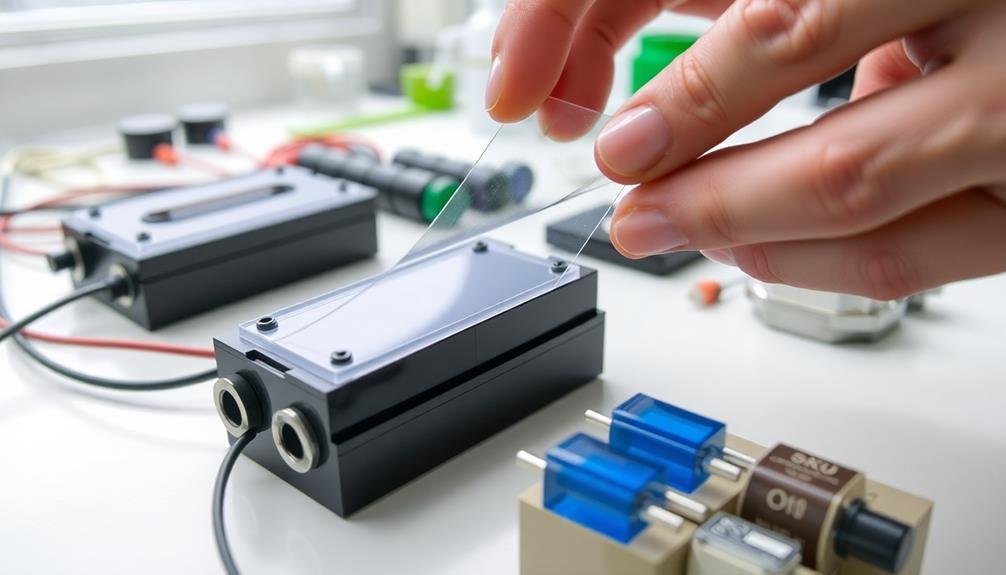
The membrane is the heart of a fuel cell stack. It's essential to choose one that's suitable for your specific application. You'll want to take into account factors like operating temperature, humidity levels, and the type of fuel you're using.
For low-temperature fuel cells, such as proton exchange membrane (PEM) cells, Nafion is a popular choice. It's known for its excellent proton conductivity and chemical stability. If you're working with higher temperatures, think about polybenzimidazole (PBI) membranes, which can withstand up to 200°C.
Pay attention to the membrane's thickness. Thinner membranes offer lower resistance but may be less durable. Thicker ones provide better mechanical strength but can reduce overall efficiency. You'll need to strike a balance based on your stack's requirements.
Don't forget about the membrane's ion exchange capacity. This property affects the cell's performance and longevity. Higher ion exchange capacity generally leads to better proton conductivity but may compromise mechanical stability.
Lastly, keep in mind the membrane's gas permeability. You'll want a membrane that minimizes gas crossover to maintain efficiency and prevent fuel loss. Look for membranes with low hydrogen and oxygen permeability for peak performance.
Prepare Catalyst Layers Carefully
You'll need to focus on uniform coating techniques when preparing catalyst layers for your fuel cell stack.
Apply the catalyst evenly across the membrane to guarantee peak performance and longevity.
Pay close attention to the catalyst loading, as too little won't provide enough reactivity, while too much can lead to unnecessary costs and potential performance issues.
Uniform Coating Techniques
Three key techniques guarantee uniform coating when preparing catalyst layers for fuel cell stacks.
First, use a spray coating method. You'll need to invest in a high-quality spray gun and practice your technique to achieve an even distribution. Adjust the spray distance, pressure, and movement speed to enhance coverage.
Second, employ doctor blade coating. This technique involves spreading a thin film of catalyst ink across the substrate using a blade. You'll need to maintain consistent pressure and speed to guarantee uniformity.
Third, consider screen printing for precise control over catalyst deposition. This method uses a mesh screen to transfer the catalyst ink onto the substrate. You'll need to choose the right mesh size and squeegee pressure for best results.
Whichever technique you choose, pay attention to ink viscosity and solid content. These factors greatly influence coating quality. Always perform test runs on sample substrates to fine-tune your parameters before coating actual components.
Remember to maintain a clean, dust-free environment during the coating process to prevent contamination. By mastering these uniform coating techniques, you'll greatly improve the performance and durability of your fuel cell stack.
Optimal Catalyst Loading
When it comes to ideal catalyst loading, precision is paramount. You'll need to carefully determine the best amount of catalyst for your fuel cell's electrode layers. Too little catalyst won't provide enough reaction sites, while too much can lead to wasted material and reduced performance.
Start by consulting your fuel cell's specifications for recommended catalyst loading ranges. Typically, you'll aim for 0.1 to 0.4 mg/cm² for platinum-based catalysts. Use a microbalance to measure your catalyst accurately, and mix it thoroughly with your chosen binder material.
Apply the catalyst mixture evenly to your gas diffusion layer or membrane using screen printing, spray coating, or doctor blade techniques. Guarantee uniform distribution across the entire active area.
After application, dry the catalyst layer carefully to remove any solvents.
Monitor your catalyst loading by weighing the electrode before and after application. If needed, adjust your process to achieve consistent results.
Optimize Gas Diffusion Layers
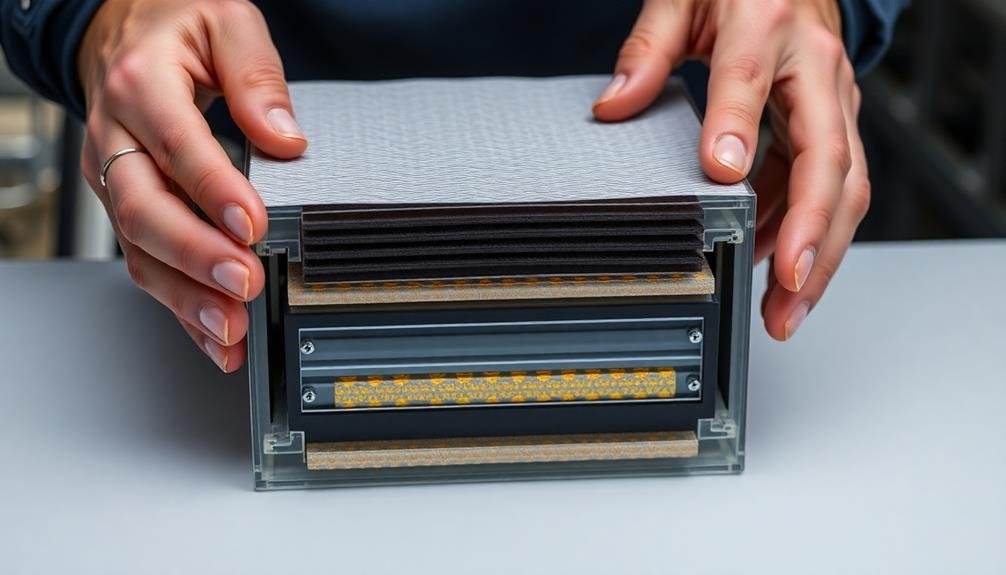
Gas diffusion layers (GDLs) play an essential role in fuel cell performance. They facilitate the transport of reactants and products while providing electrical conductivity and mechanical support. To optimize your GDLs, you'll need to take into account several factors that impact their effectiveness.
First, focus on the GDL's porosity and thickness. A balance between these properties guarantees efficient gas diffusion and water management. You'll want to select GDLs with appropriate pore size distribution to prevent flooding while maintaining adequate reactant transport.
Next, evaluate the GDL's hydrophobicity. Treating the GDL with a hydrophobic coating, such as PTFE, can improve water management and prevent excessive liquid accumulation. However, be careful not to over-treat, as this can hinder gas transport.
Finally, pay attention to the GDL's compression characteristics. Proper compression is vital for maintaining electrical contact and reducing contact resistance.
To further optimize your GDLs:
- Experiment with different carbon-based materials (e.g., carbon paper, carbon cloth) to find the best fit for your fuel cell design.
- Consider using microporous layers (MPLs) to enhance water management and reduce flooding.
- Implement quality control measures to guarantee consistent GDL properties across your fuel cell stack.
Align Bipolar Plates Precisely
When aligning bipolar plates in your fuel cell stack, precision is vital.
You'll want to use alignment guides to guarantee each plate is positioned correctly, and it's imperative to check the flatness of each plate before assembly.
Don't forget to verify the correct orientation of the plates, as improper placement can markedly impact the stack's performance.
Use Alignment Guides
Proper alignment of bipolar plates is essential for ideal fuel cell performance. To achieve this, you'll need to use alignment guides. These tools guarantee that each component of your fuel cell stack is positioned correctly, minimizing errors and optimizing efficiency.
When using alignment guides, follow these key steps:
- Select the appropriate guide: Choose guides that match your specific bipolar plate dimensions and stack design. Custom-made guides often work best for unique configurations.
- Position the guides: Place them on a flat surface, making sure they're level and stable. Use a spirit level to confirm accuracy.
- Insert plates carefully: Slide each bipolar plate into the guides, making sure they fit snugly without forcing or bending them.
As you assemble your stack, periodically check that the guides haven't shifted. You'll find that using these tools considerably reduces assembly time and improves overall stack quality.
Check Plate Flatness
Precision is paramount when aligning bipolar plates in your fuel cell stack. To guarantee peak performance, you'll need to check the flatness of each plate before assembly.
Start by placing the bipolar plate on a flat surface, such as a precision-ground granite table. Use a set of feeler gauges to measure any gaps between the plate and the surface. These gaps indicate warping or unevenness.
For best results, check multiple points along the plate's edges and center. If you find deviations greater than 0.05mm, the plate may need to be replaced or resurfaced. Pay special attention to the flow field channels, as even slight distortions can disrupt reactant distribution and compromise cell efficiency.
You can also use a dial indicator mounted on a surface plate to measure flatness more precisely. Move the indicator across the plate's surface, noting any variations in height. Remember, even minor imperfections can stack up when you're assembling multiple cells, potentially leading to uneven compression and poor electrical contact.
If you're working with flexible graphite plates, be extra cautious, as they're more prone to warping. Always handle them carefully and store them flat to maintain their shape.
Verify Correct Orientation
Alignment is critical when assembling your fuel cell stack. Each bipolar plate must be oriented correctly to guarantee proper flow of reactants and efficient electrical conductivity. You'll need to pay close attention to the plate's design features, such as flow channels and gasket grooves, to determine the correct orientation.
Remember, even a single misaligned plate can compromise the entire stack's performance.
To verify correct orientation:
- Identify the anode and cathode sides of each plate, often marked with different textures or colors.
- Check for alignment pins or holes that should line up with adjacent components.
- Confirm that flow channel patterns match between adjacent plates when stacked.
Use an assembly jig or guide to maintain consistent orientation throughout the stack-building process.
It's helpful to create a visual reference or diagram to double-check each plate's position as you assemble. If you're working with a team, establish a clear system for verifying orientation at each step.
Don't rush this process; take the time to confirm each plate's alignment before moving on. By guaranteeing correct orientation, you'll maximize your fuel cell stack's efficiency and prevent potential leaks or short circuits that could damage the system.
Ensure Proper Sealing
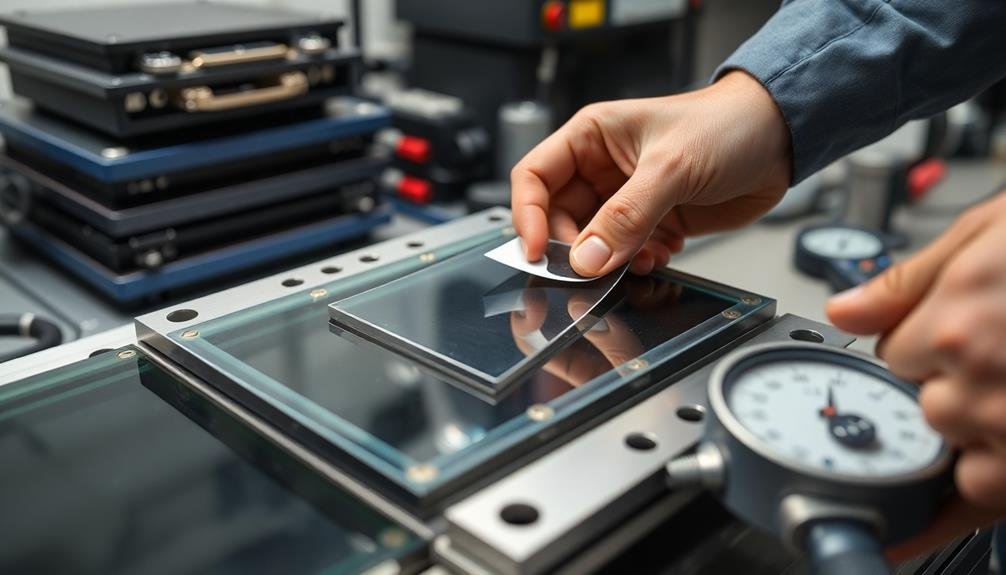
Why is sealing so essential in a fuel cell stack? Proper sealing prevents gas leaks and guarantees efficient operation. Without adequate sealing, hydrogen and oxygen can mix, compromising safety and reducing performance.
It's vital to maintain the separation of reactants and protect the electrolyte membrane.
To guarantee proper sealing, you'll need to use high-quality gaskets designed specifically for fuel cells. Place these gaskets between each cell component, making sure they're correctly aligned and free from defects.
Apply consistent pressure across the entire stack when tightening bolts to create an even seal.
Don't forget to check for proper compression of the gaskets. Over-compression can damage components, while under-compression may lead to leaks. Use a torque wrench to achieve the manufacturer's recommended tightness.
Consider using a sealant or adhesive compatible with fuel cell materials for added protection. Apply it sparingly to avoid interfering with electrical connections or reactant flow.
Apply Correct Compression Force
Having guaranteed proper sealing, the next step in assembling your fuel cell stack is to apply the correct compression force. This vital step guarantees ideal contact between components and maintains the stack's integrity.
You'll need to strike a balance – too little pressure can lead to poor electrical contact and gas leaks, while excessive force may damage delicate components.
To apply the correct compression force:
- Consult your fuel cell's specifications for the recommended compression range, typically measured in pounds per square inch (PSI) or newtons per square meter (N/m²).
- Use a torque wrench to tighten the bolts in a cross-pattern sequence, gradually increasing torque to the specified value.
- Monitor the stack's thickness during compression, confirming it remains within the manufacturer's tolerances.
Test for Leaks Thoroughly
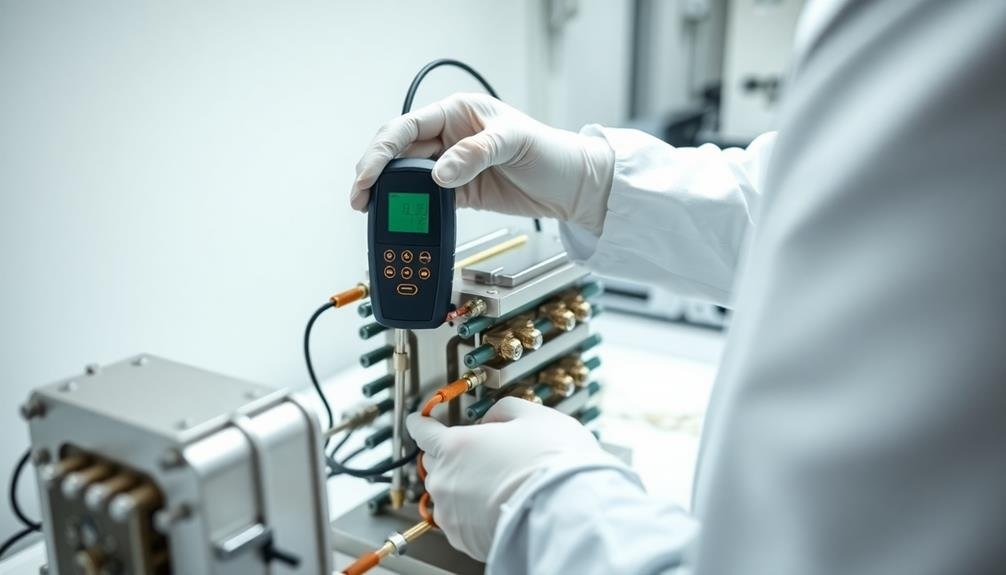
Safety is paramount when assembling a fuel cell stack, and thorough leak testing is a critical step. You'll need to conduct a series of tests to verify your stack is leak-free before operation.
Start by pressurizing the stack with an inert gas like nitrogen or helium. Use a pressure gauge to monitor any drop in pressure over time, which could indicate a leak.
Next, apply a soapy water solution to all joints, seals, and connections. Watch for bubbles forming, as they'll reveal the location of any leaks. For more precise detection, use an electronic leak detector or perform a helium leak test using a mass spectrometer.
Don't forget to check both the anode and cathode sides of the stack separately. Pay special attention to areas around gaskets, manifolds, and end plates.
If you find any leaks, mark their locations and address them immediately. This might involve tightening bolts, replacing gaskets, or resealing joints.
After making repairs, repeat the leak tests to confirm you've resolved all issues.
Frequently Asked Questions
How Long Does a Typical Fuel Cell Stack Last Before Needing Replacement?
You'll find that a typical fuel cell stack can last 5-15 years, depending on usage and maintenance. It's important to monitor performance and replace components as needed. Regular upkeep can extend your stack's lifespan markedly.
What Safety Precautions Should Be Taken When Handling Fuel Cell Components?
When handling fuel cell components, you'll need to wear protective gear like gloves and goggles. Guarantee proper ventilation, avoid static electricity, and handle chemicals carefully. Don't forget to follow manufacturer guidelines and keep a fire extinguisher nearby.
Can I Assemble a Fuel Cell Stack at Home or in a Non-Specialized Workshop?
You shouldn't attempt to assemble a fuel cell stack at home or in a non-specialized workshop. It's risky and requires specialized equipment and expertise. Instead, consider purchasing pre-assembled stacks or working with professionals in a proper facility.
How Does Temperature Affect Fuel Cell Stack Performance and Assembly Procedures?
You'll find that temperature greatly impacts fuel cell performance. Higher temps boost efficiency but can degrade materials. During assembly, you'll need to control temperature carefully to guarantee proper sealing and prevent warping of components.
Are There Any Eco-Friendly Alternatives for Traditional Fuel Cell Stack Materials?
You'll find several eco-friendly alternatives for fuel cell stack materials. Consider using recycled platinum, bio-based membranes, or carbon nanotubes. You can also explore ceramic-based electrolytes and sustainable catalyst coatings to reduce environmental impact in your fuel cell designs.
In Summary
You've now got the key steps to assemble your fuel cell stack like a pro. Remember, it's all about precision and attention to detail. Don't rush the process; take your time with each component. By following these expert tips, you'll create a more efficient and reliable fuel cell stack. Keep practicing and refining your technique. With patience and care, you'll soon be assembling high-quality fuel cells with confidence.

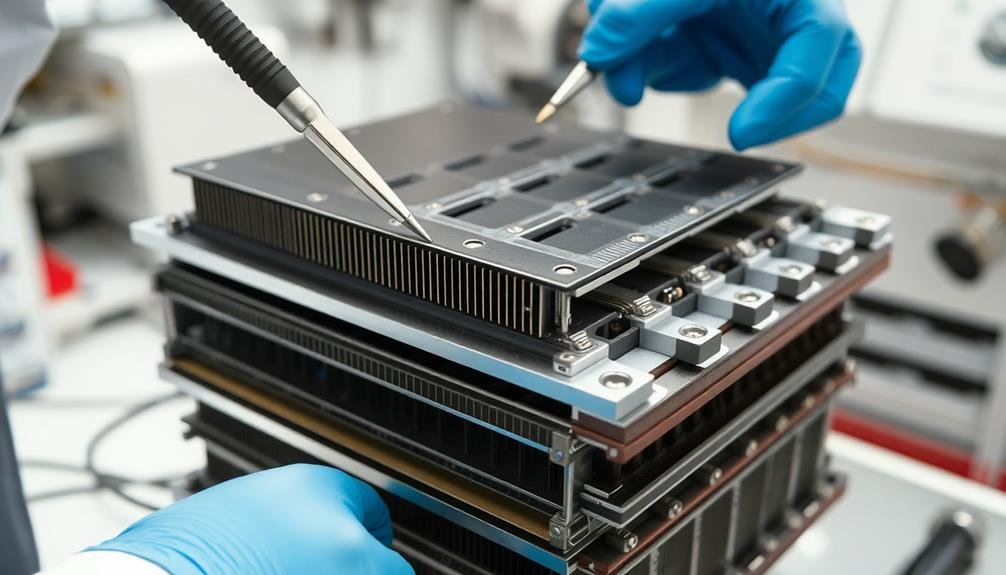



Leave a Reply